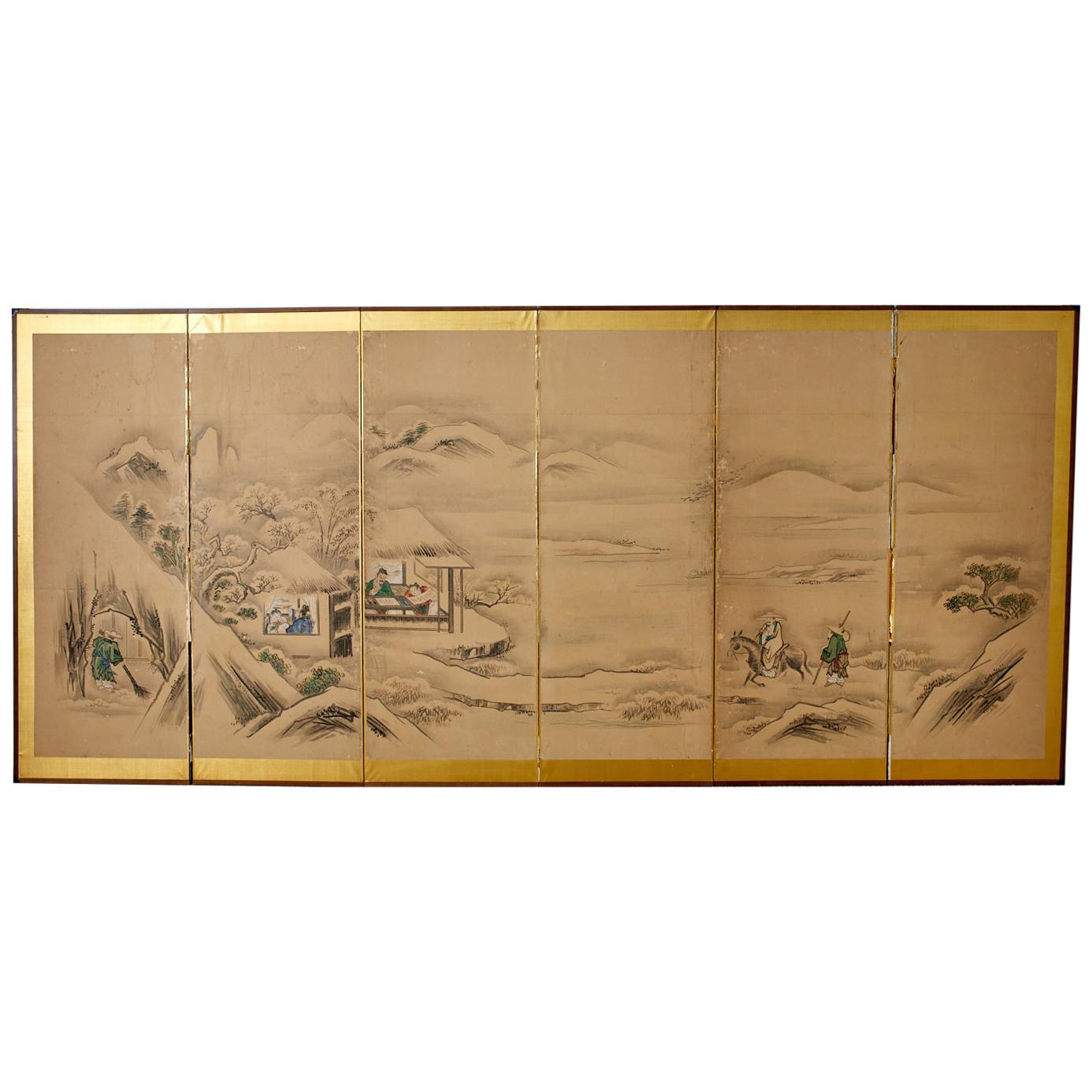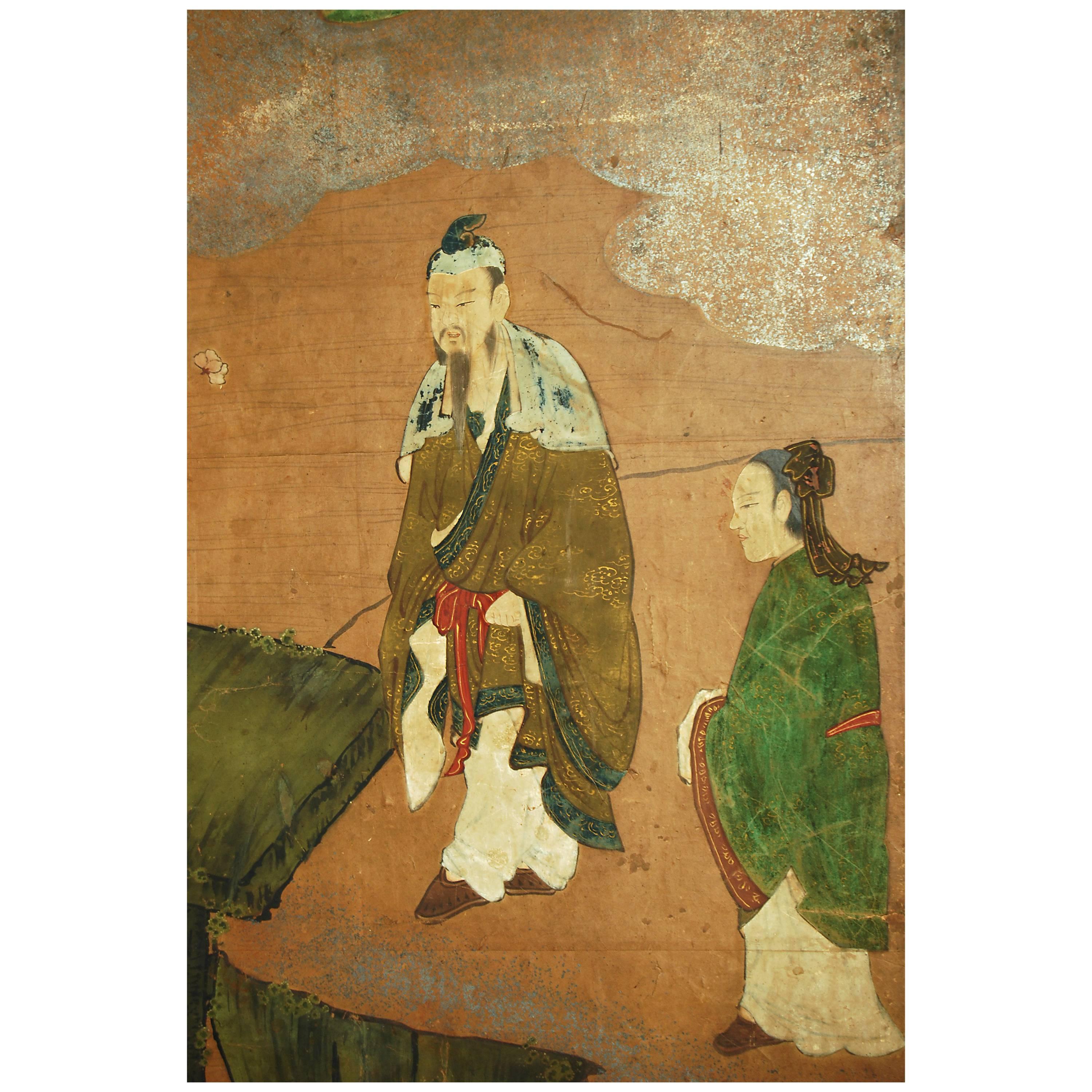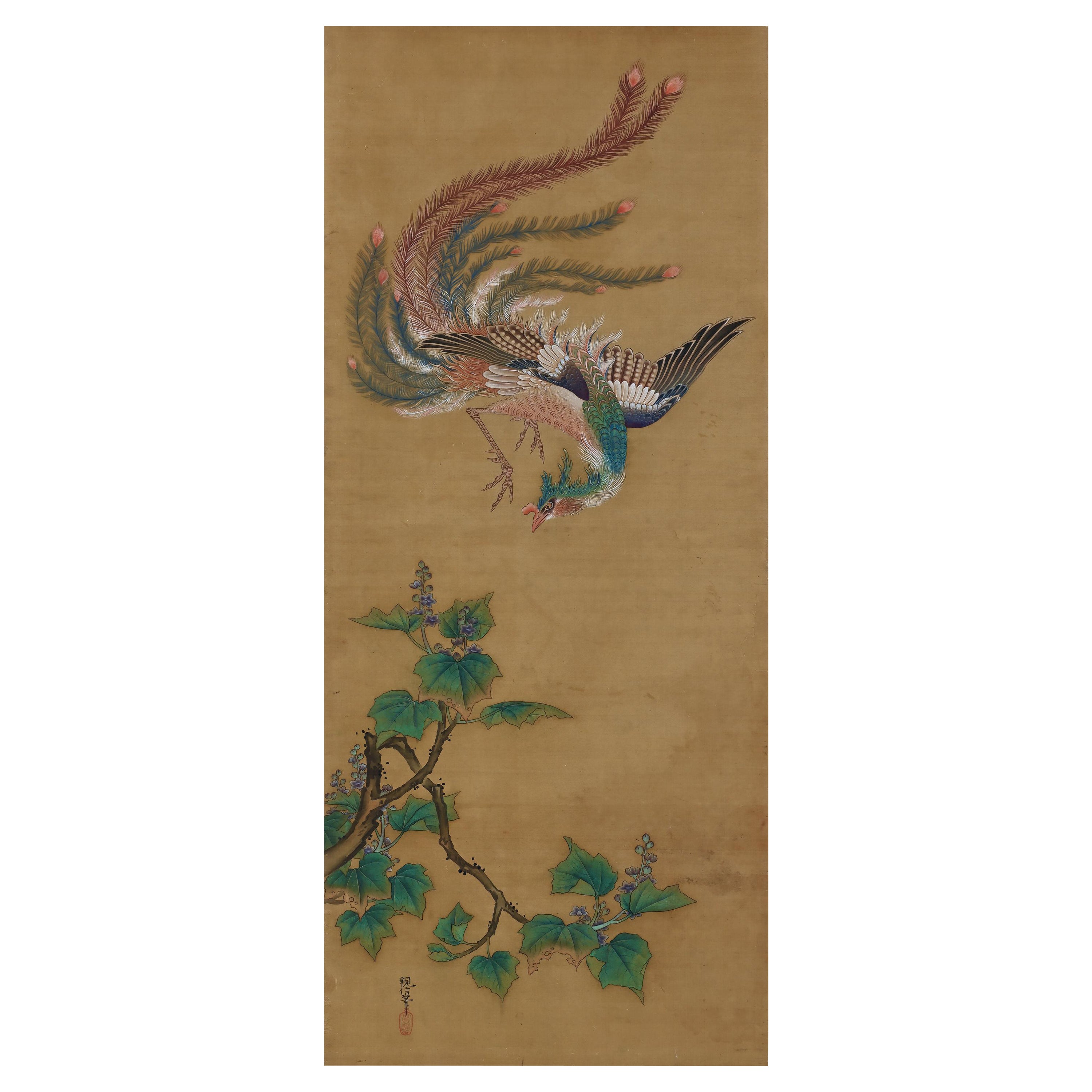Items Similar to Japanese Screen Pair, circa 1730, Peacocks and Phoenix, Kano School
Want more images or videos?
Request additional images or videos from the seller
1 of 10
Japanese Screen Pair, circa 1730, Peacocks and Phoenix, Kano School
About the Item
Phoenix and Peacocks.
A pair of six-panel Japanese folding screens by Tsunetake Yotei (n.d.)
First half of the 18th century.
The signature reads 67 year old Tsunetake.
The seals read:
-Tsunetake no in,
-Yotei,
-Seishin
Dimensions:
Each screen – H. 69” x W. 149” (176 cm x 378 cm)
A pair of Kano Grand Picture (Waga) screens depicting phoenix and peacocks rich with symbolic meaning. Dating to the first half of the 18th century, from the Kobikicho Kano school in Edo, this pair of folding screens spring from the height of the Japanese Tokugawa reign. The Kano school of art was within the Tokugawa dispensation and provided for its internal needs rather than a public constituency. A Kano decorated castle, or temple, was a way to acquire military standing and to ensure confidence in the steadfastness of their virtue. Temple residences, especially senior abbacies, were decorated similarly to castles, unsurprisingly as they were sponsored by the same warriors. Beyond image halls and places of ritual exercise, temples had abbacies, monastic living quarters and guest houses, all of which would be ornamented, as rich as any mansion, and in not a dissimilar way.
Kano Grand-Picture Waga invokes the broad notion of auspiciousness, especially its political dimension. The mythical phoenix was a symbol of peace and would only appear in a kingdom blessed with prosperity during the reign of a virtuous emperor. The paulownia tree was regarded as sacred and home to the phoenix, and the phoenix and paulownia together carried strong auspicious connotations. Peacocks communicate high status, wealth and power. This pair of screens would have left no doubt as to the status of their owner or patron.
Waga was understood as bold and colorful, with copious use of gold. The artists strived for luxurious tints and beautiful appearances. This pair of screens epitomize the concept and the startlingly fresh pigments and sublimely hued gold leaf effortlessly sweep the viewer to a previous epoch.
Tsunetake Yotei was an artist of the Kano school. He is listed in Araki Nori. Dai-Nihon Shoga Meika Taikan (Dictionary of Great Japan Calligraphy and Painting Masters). Tokyo: Dai-ichi Shobo. 1975. p.2435. His dates are unknown. Almost certainly he was a student of Kano Tsunenobu Yoboku (1636-1713) of the Kobikicho Kano. All of Tsunenobu’s well-known students used the first and third characters of his name, as is the case with Tsunetake Yotei.
- Dimensions:Height: 69 in (175.26 cm)Width: 149 in (378.46 cm)Depth: 0.75 in (1.91 cm)
- Sold As:Set of 2
- Style:Edo (Of the Period)
- Materials and Techniques:
- Place of Origin:
- Period:
- Date of Manufacture:circa 1730
- Condition:Wear consistent with age and use.
- Seller Location:Kyoto, JP
- Reference Number:1stDibs: LU2472319431222
About the Seller
5.0
Recognized Seller
These prestigious sellers are industry leaders and represent the highest echelon for item quality and design.
Established in 2001
1stDibs seller since 2016
60 sales on 1stDibs
Typical response time: 6 hours
- ShippingRetrieving quote...Ships From: Kyoto, Japan
- Return PolicyA return for this item may be initiated within 10 days of delivery.
More From This SellerView All
- Circa 1700 Japanese Screen Pair, Cranes & Pines, Kyoto Kano SchoolLocated in Kyoto, JPPines and Cranes Anonymous. Kyoto Kano School. Late 17th/early 18th centuries, circa 1700. Pair of six-panel Japanese folding screens. Ink, gofun, pigment and gold leaf on paper. This bold composition presents two pine trees extending to the left and right across a gold leaf background. One tree is silhouetted against a green ground, golden clouds obscuring its true size, the other stretches across a stylized waterway. The pines are paired with Manchurian cranes with red crests and snow white plumage. Both have been highly auspicious motifs in East Asia since Chinese antiquity. Here the artist utilized fluid and instinctive ink brushstrokes to define the trunk, branches and tail feathers, in strong contrast to the precision and sharp angularity of the crane’s legs and beaks. The adoption of this vast metallic painting support required an unerring sense of design and composition, so that the negative space surrounding motifs could imply context for the otherwise floating pictorial elements. The brushwork detailing the trunks of the pines, the exaggerated dimensions of the pine trees and the strength and dynamism of the composition are all reminiscent of Kano Eitoku...Category
Antique Late 17th Century Japanese Edo Paintings and Screens
MaterialsGold Leaf
- Japanese Screen Painting, circa 1700 'Horses' by Kano TanshinLocated in Kyoto, JPHorses Kano Tanshin Morimasa (1653-1718) Two-panel tea-ceremony Japanese screen or furosaki Ink on gold leaf, late 17th-early 18th century Measures: H 55 cm x W 182 cm The Kano school was closely aligned with the warrior class in Japan. The samurai, who lived in a closed and rigid hierarchical society established by the Shogunate, were drawn to the energy and freedom horses symbolize; Kano school artists commonly depicted the equine creatures as they are here, in unfettered and carefree family groups. China originally introduced horse paintings to Japan; the works typically focused on capturing the essence of horses in their various environments and often involved integrating human figures into the images. Kano Tanshin Morimasa (1653-1718) was the son of Kano Tanyu...Category
Antique 1690s Japanese Edo Paintings and Screens
MaterialsGold Leaf
- 19th Century Japanese Silk Painting by Kano Chikanobu, Phoenix & PaulowniaLocated in Kyoto, JPBirds & Flowers of the seasons Pheasants & Plum in Snow Unframed painting. Ink, pigment and gofun on silk Kano Chikanobu 1819-1888 Signature...Category
Antique Mid-19th Century Asian Edo Paintings and Screens
MaterialsSilk
- 19th Century Japanese Silk Painting by Kano Chikanobu, Peacock & BambooLocated in Kyoto, JPBirds & Flowers of the Seasons Pheasants & Plum in Snow Unframed painting. Ink, pigment and gofun on silk Kano Chikanobu 1819-1888 Signature...Category
Antique Mid-19th Century Asian Edo Paintings and Screens
MaterialsSilk
- 17th Century Japanese Screen. Ink Plum Tree & Birds by Kano Naonobu.Located in Kyoto, JPKano Naonobu (1607-1650) Plum Tree and Birds Six-fold Japanese Screen. Ink and slight color on paper. In this evocative ink work spread over a six-panel folding screen, we see the consummation of the elegance and refinement of the Edo Kano school. This 17th century screen is a rare surviving example of a large-scale bird and flower painting by Kano Naonobu, the younger brother of Kano Tanyu...Category
Antique 17th Century Japanese Edo Paintings and Screens
MaterialsWood, Paper
- 18th Century Japanese Screen Pair. Plum & Young Pines. Kano School.Located in Kyoto, JPDimensions (Each screen): H. 176 cm x W. 378 cm (69’’ x 149’’) This pair of Japanese folding screens depict blossoming plum trees amongst young pines. They are designed to capture t...Category
Antique Late 18th Century Japanese Edo Paintings and Screens
MaterialsGold Leaf
You May Also Like
- Japanese Six Panel Kano School Winter Landscape ScreenLocated in Rio Vista, CALarge Japanese Meiji period six-panel screen depicting a winter landscape with a Chinese sage visiting friends in a country villa. Ink and vivid color pigments on mulberry paper mounted to a gilt background. Painted in the 19th century Kano school...Category
Antique 19th Century Japanese Meiji Paintings and Screens
MaterialsMetal
- 19th Century Japanese Edo Six Panel Kano School Landscape ScreenLocated in Rio Vista, CALate Edo period 19th century Japanese six-panel landscape screen featuring a cypress tree over a flowering hibiscus with a pair of hototogisu birds. Kano school painted with ink and ...Category
Antique 19th Century Japanese Edo Paintings and Screens
MaterialsSilk, Wood, Paper
- 18th Century Japanese Kano School Landscape ScreenLocated in Prahran, VictoriaJapanese Kano school screen with pine tree, camellias, cherry blossom and Chinese figures in the landscape, circa 18th century. Materials: Pigmen...Category
Antique 18th Century Japanese Paintings and Screens
MaterialsSilver Leaf
- Kano school pine screenLocated in Fukuoka, JP18th Century Kano School Pine Screen Delve into the historic brilliance with this majestic gold-leafed screen from the renowned Kano School. The grand green pine, a recurrent motif in Japanese art...Category
Antique 18th Century Japanese Edo Paintings and Screens
MaterialsGold Leaf
- Pair of Japanese Edo Rimpa School Screens after Tawaraya SotatsuLocated in Rio Vista, CAImpressive pair of 17th century Japanese Edo period Rinpa school screens made in the manner and style of Autumn Grasses by Tawaraya Sotatsu (1570-1640). Beautifully decorated with wi...Category
Antique 17th Century Japanese Edo Paintings and Screens
MaterialsGold Leaf
- Japanese Edo Four Panel Screen Kano School Filial PietyLocated in Rio Vista, CAEarly 19th century late Edo period Japanese four-panel screen depicting examples from the 24 paragons of filial piety. Painted in the Kano School style featuring figures in colorful,...Category
Antique 19th Century Japanese Edo Paintings and Screens
MaterialsBrass, Gold Leaf





